Note: This publication is currently undergoing major revisions. The current publication will be replaced with a new publication based on stakeholder requirements and scientific advances. We expect to begin sharing details on this soon. If you have input on content, format, or publication frequency at any time, please contact us at cbrfc.webmasters@noaa.gov.Green Water Supply Outlook, June 1, 2011Green Water Supply Outlook, June 1, 2011
Contents
Green Summary
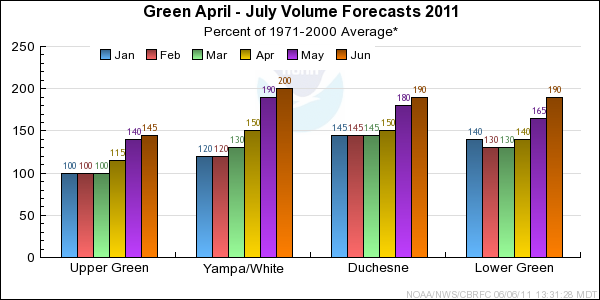
*Median of forecasts within each basin.
Upper Green Basin Conditions
Forecasts for Hams Fork, Blacks Fork, and Flaming Gorge inflow are in the top five historical observed
volumes.
The following conditions influenced this month's forecasts:
Precipitation:
Seasonal October through May
precipitation was 140 percent of average
in the Upper Green basin. May
precipitation was 200 percent of average in
the basin as a whole.
Snow:
June 1st snow water equivalent was 360 percent of average in the basin; please note that
this time of year the percent of average may not provide a valid measure of current conditions. The seasonal
peak occurred near mid April and was near 135 percent of average. However, it should be noted that there are no snotel
locations above 10,000 ft making it difficult to determine the current snowpack conditions.
--- Upper Green basin
snow
water equivalent plot.
Streamflow:
May streamflow was near 95 percent of average.
Soil Moisture:
Modeled
soil
moisture states were below average heading into the winter.
Climate Forecasts:
Climate forecasts were not a factor because there is not a strong correlation
between La Nina conditions and winter precipitation in the Upper Green basin.
Forecast Summary:
Most forecast volumes increased from last month due to the much above average precipitation in May and cold temperatures which
have delayed the snow melt. Snowpack and seasonal precipitation were still both much above average on June 1st.
As a result of the current conditions, the April through July streamflow
volume forecasts increased by approximately 5 to 10 percent from the May 1 forecasts.
Current forecasts range between 115 and 181 percent of average with a median value of 145 percent.
Forecasts for Hams Fork, Blacks Fork, and Flaming Gorge inflow are in the top five historical observed
volumes.

* Percent usable capacity, not percent average contents.
Click for multi-month Graph.
Yampa/White Basin Conditions
All of these forecast volumes are at or above the record volume with the exception of the White River.
The following conditions influenced this month's forecasts:
Precipitation:
Seasonal October through May
precipitation was 140 percent of average
in the Yampa/White basin. May
precipitation was 155 percent of average in
the basin as a whole.
Snow:
June 1st snow water equivalent was 274 percent of average in the basin; please note that
this time of year the percent of average may not provide a valid measure of current conditions.
A wet and cold May has delayed snow melt and on June 1st there was still 135% of the seasonal peak, which typically
occurs in mid April, at snotels above above 9,500ft. Many of the snotels in the basin have record snow water equivalent.
--- Yampa basin
snow
water equivalent plot.
Streamflow:
May streamflow was near 115 percent of average.
Soil Moisture:
Modeled
soil
moisture states were near average heading into the winter for the Yampa, Little Snake,and
White River basins.
Climate Forecasts:
Climate forecasts were not a factor in the forecasts because there is not a strong correlation
between La Nina conditions and winter precipitation in the Yampa/White basin.
Forecast Summary:
Most forecast volumes increased from last month due to the much above average precipitation in May and cold temperatures which
have delayed the snow melt. Snowpack and seasonal precipitation were still both much above average on June 1st.
It is also important to note that many of the snotel locations
have record snow water equivalent for June 1. As a result of the current conditions,
the April through July streamflow volume forecasts have increased by approximately
5 to 10 percent. Current forecasts range between 161 and 242 percent of average
with a median value of 200 percent.
All of these forecast volumes are at or above the record volume with the exception of the White River.
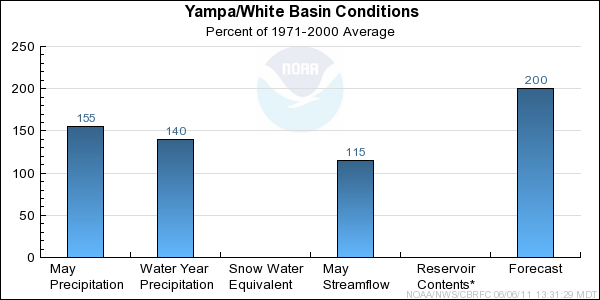
* Percent usable capacity, not percent average contents.
Click for multi-month Graph.
Duchesne Basin Conditions
Many of these forecast volumes are in the top five historical observed volumes.
The following conditions influenced this month's forecasts:
Precipitation:
Seasonal October through May
precipitation was 165 percent of average
in the Duchesne basin. May
precipitation was 200 percent of average the basin
as a whole.
Snow:
June 1st snow water equivalent was 385 percent of average in the basin; please note that
this time of year the percent of average may not provide a valid measure of current conditions. A wet and cold May has
delayed snow melt and on June 1st there was still 100% of the seasonal peak, which typically
occurs in mid April. However, the majority of the snow exists in areas above 10,000ft.
--- Duchesne basin
snow
water equivalent plot.
Streamflow:
May streamflow was 80 percent of average.
Soil Moisture:
Modeled
soil
moisture states were much below average to below average heading into the winter.
Climate Forecasts:
Climate forecasts were not a factor in the forecasts because there is not a strong correlation
between La Nina conditions and winter precipitation in the Duchesne basin.
Forecast Summary:
Most forecast volumes increased from last month due to the much above average precipitation in May and cold temperatures which
have delayed the snow melt. Snowpack and seasonal precipitation were still both much above average on June 1st.
As a result of the current conditions, the majority of the April through July streamflow
volume forecasts increased by approximately 5 to 10 percent.
Current forecasts range between 108 and 275 percent of
average with a median value of 188 percent.
Many of these forecast volumes are
in the top five historical observed volumes.

* Percent usable capacity, not percent average contents.
Click for multi-month Graph.
Lower Green Basin Conditions
Many of these forecast volumes are in the top five historical observed volumes.
The following conditions influenced this month's forecasts:
Precipitation:
Seasonal October through May
precipitation was 165 percent of average
in the Lower Green basin. May
precipitation was 190 percent of average.
Snow:
June 1st snow water equivalent was 445 percent of average in the basin; please note that
this time of year the percent of average may not provide a valid measure of current conditions. Typically, the snow
has melted out in this basin by June 1. However, currenlty there is still a small amount of snow located only at the highest elevations.
--- Lower Green basin
snow
water equivalent plot.
Streamflow:
May streamflow was near 115 percent of average.
Soil Moisture:
Modeled
soil
moisture states were much below to near average heading into the winter.
Climate Forecasts:
Climate forecasts were not a factor in the forecasts because there is not a strong correlation
between La Nina conditions and winter precipitation in the Lower Green basin.
Forecast Summary:
Most forecast volumes increased slightly from last month due to the much above average precipitation in May and cold temperatures which
have delayed the snow melt. As a result of the current conditions, the majority of the April through July streamflow
volume forecasts increased, by approximately 5 to 10 percent.
Current forecasts range between 163 and 212 percent of
average with a median value of 190 percent.
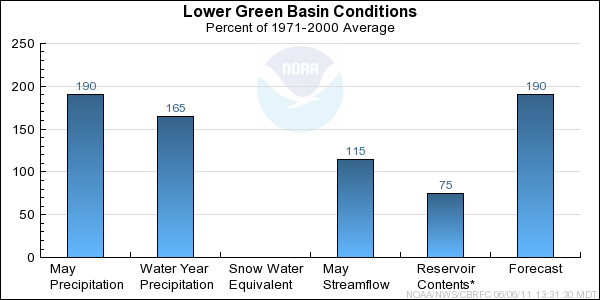
* Percent usable capacity, not percent average contents.
Click for multi-month Graph.
Differences between the full period forecasts and the residual forecasts may not exactly equal the actual observed volumes due to rounding conventions (see Definitions section).
Reservoir Monthly Inflow Forecasts
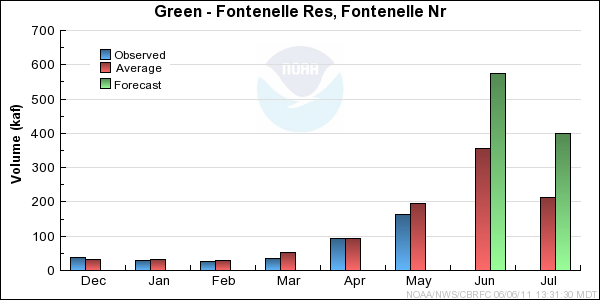
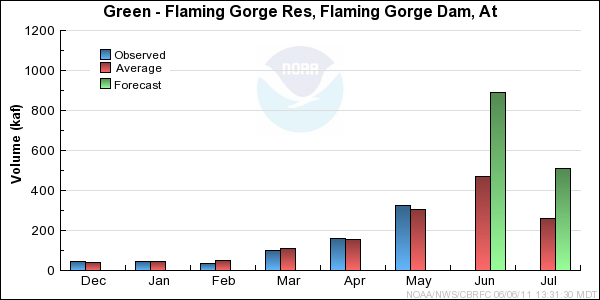
Monthly Streamflows


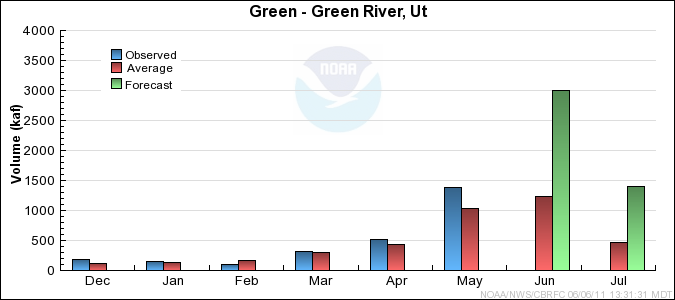
Precipitation Maps
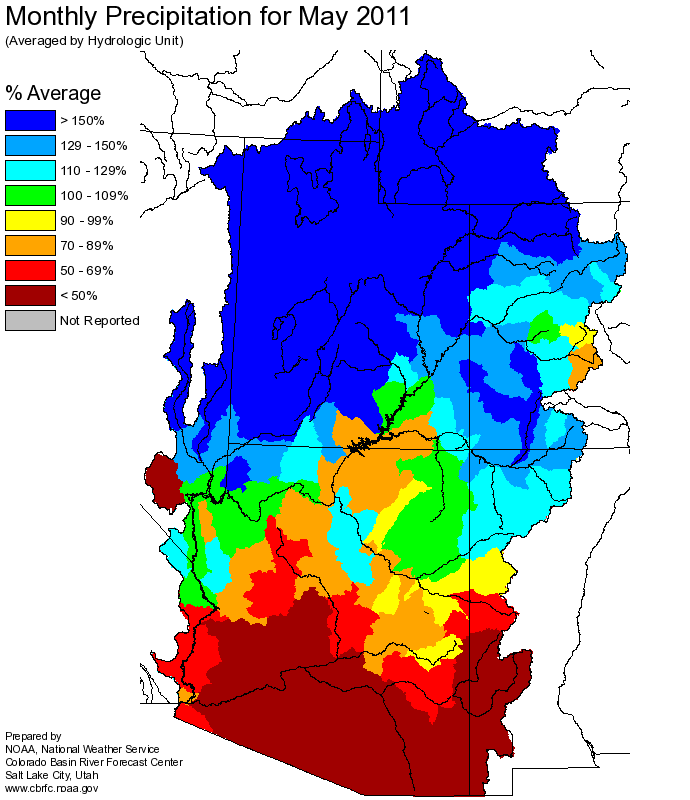
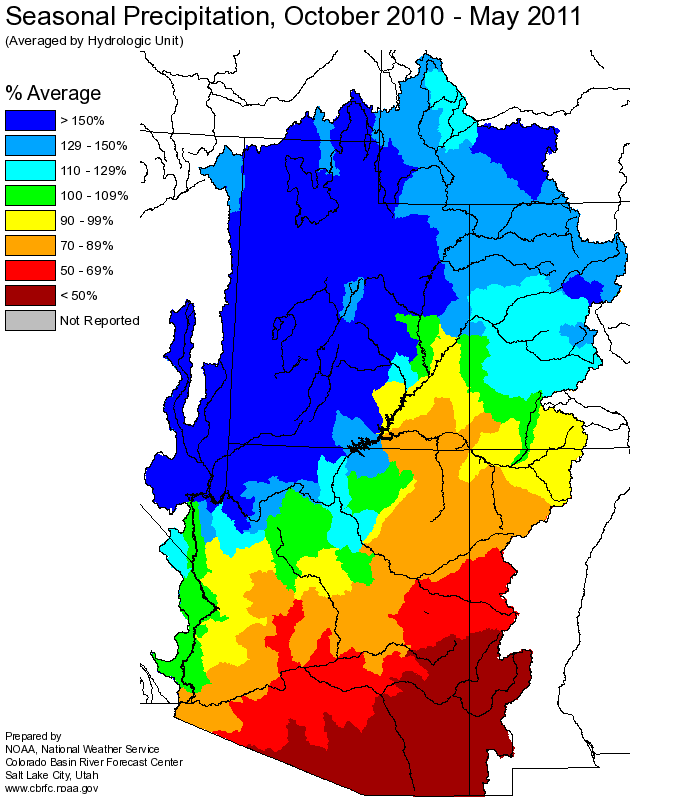
Hydrologist: Ashley Nielson













